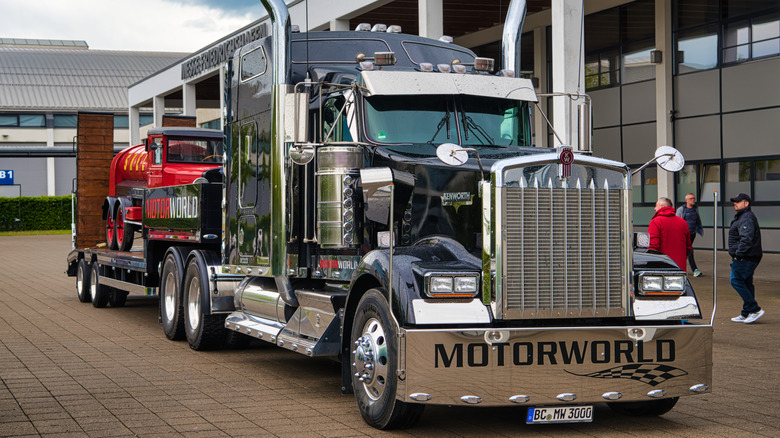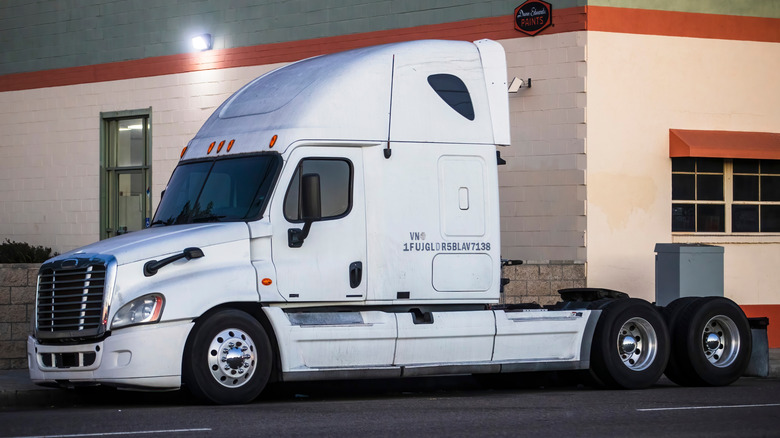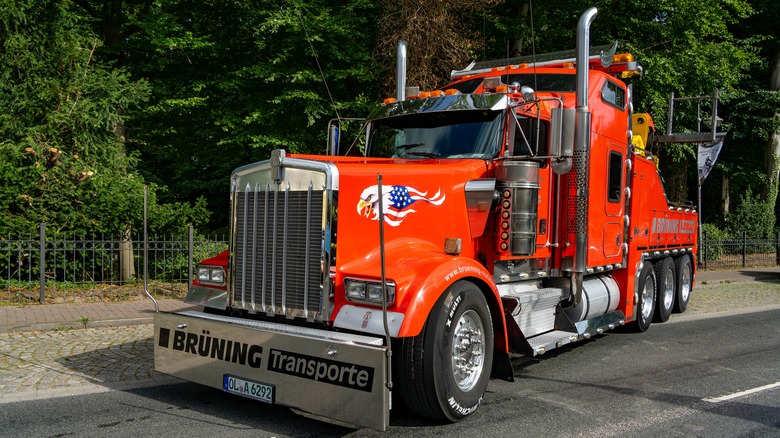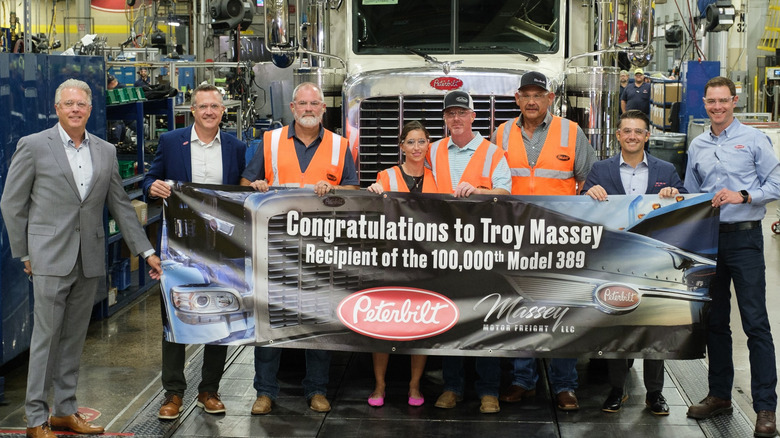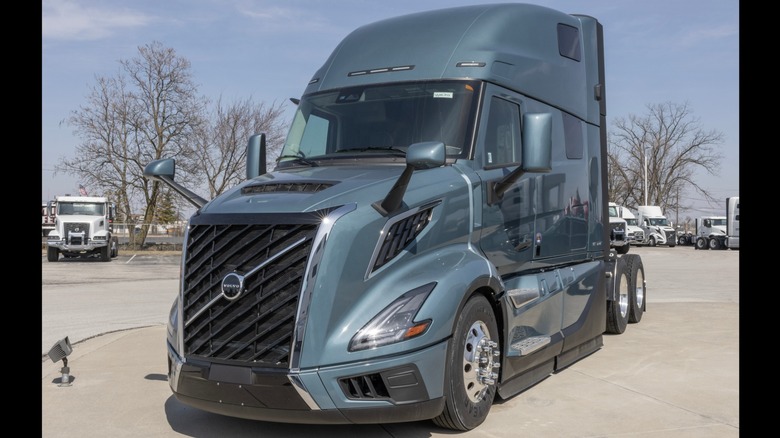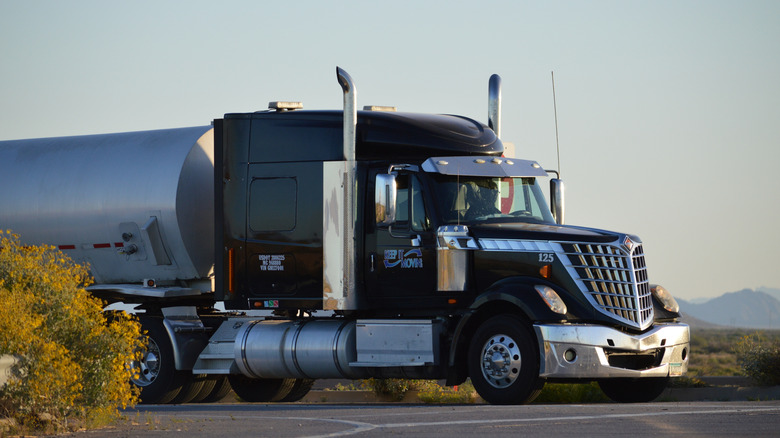5 Of The Most Iconic Semi-Trucks Powered By The Cummins X15 Engine
Given its vast popularity, it's fair to say that the Cummins X15 engine is the backbone of the American freight trucking industry. And while Cummins makes several heavy-duty truck engines, as the company's flagship unit, the X15 combines massive torque output with a surprising level of efficiency. In terms of metrics, the X15 displaces 14.9 liters, makes between 400 and 670 hp, and produces 1,450 to 2,050 lb-ft of torque, qualifying it as one of the most powerful semi-truck engines. In addition, it is 49 inches tall, 38 inches wide, 55 inches long, and weighs 2,961 pounds without fluids. The X15 also enjoys great aftersales support from Cummins, with a 250,000-mile warranty and a host of tech features,and is available in three main series: Productivity, Performance, and Efficiency.
The X15 powers many models, can be pretty fuel-efficient, and complies with the latest emission standards. There are also variants of the X15 that run on natural gas, further reducing the environmental impact of the operator, making it easy to see why this engine is so popular nowadays. But an engine is only as reputable as the trucks that carry it, and the X15 has found its way into some of the most legendary semi-trucks ever to grace American highways. Here are five of the most iconic semi-trucks powered by Cummins' legendary X15 engine.
Freightliner Cascadia (Next Gen)
First up is the Next Gen Freightliner Cascadia, a workhorse semi-truck that makes up the lion's share of many commercial fleets. As a matter of fact, Freightliner is the king of the hill when it comes to truck sales, holding the top slot in class eight semi-trucks with a 36% market share, and 19.9% market share for classes four through seven — behind only Ford.
The Cascadia is Freightliner's flagship model. It was specifically designed to minimize running costs for the operator, which is why it focuses so much on efficiency. The latest model is more than 8% more fuel-efficient than previous generations. The latest fifth-generation Cascadia will ship with either the Cummins X15 or X15N, rated for 400 to 525 hp and up to 1,850 lb-ft of torque, though the default option remains the Detroit DD16 for now.
If spec'd with the Cummins powerplant, the Cascadia will be paired to a 12-speed Eaton-Cummins gearbox and is available in three cab configurations. These are the day cab (116- and 126-inch variants), mid-roof sleeper cab (with 48-, 60-, or 72-inch extensions), and a high-roof sleeper cab available in 60- or 72-inch extensions. Standard equipment on the Cascadia includes adaptive cruise control, a forward-facing camera, lane departure warning, automatic emergency braking, power-adjustable side mirrors, a digital instrument cluster, and a 7-inch infotainment touchscreen that's compatible with both Apple CarPlay and Android Auto.
Kenworth W900L
Kenworth is one of the most popular semi-truck brands in America, and it has plenty of well-regarded models under its belt, including the iconic Kenworth K-100 that was discontinued in 2002, and the W900L that is still on sale today. The "L" in W900L stands for "Long", which is fitting because it has a sizable cab, measuring a full 130 inches from the bumper to the back of the cab, a metric commonly abbreviated as BBC length in the industry. Additionally, the design is a key talking point on the W900L, as it is reminiscent of the very first W900 released in 1963 , making the new model look remarkably retro for today's day and age.
Logically then, if the design hasn't advanced much in the past 60 or so years, won't the W900L be extremely un-aerodynamic? Kenworth combines aesthetics with efficiency and functionality on the W900L, and the buyers know this full well. Confusingly, Kenworth also has a special edition of the W900, called the W900L Limited Edition, of which 900 units were made. Both variants of the W900 can be optioned with the Cummins X15, which produces 565 hp and up to 2,050 lb-ft of torque paired with an Eaton Fuller 13-speed transmission. For better or worse, Kenworth will discontinue the W900L in 2026, along with some other Kenworth models as they fail to keep up with emissions regulations. This adds a premium to newer Kenworth W900L units, so grab one while you can if you're in the market.
Peterbilt 389
Although the Peterbilt trucks now mostly come with Paccar MX-series engines, the Cummins X15 still remains an option on many of the top models. One such truck that offered the X15 is the top-of-the-range Peterbilt 389, which replaced the legendary 379 when it launched in 2007, and which itself was replaced by the Peterbilt 589 in 2023. On the 389, the Cummins diesel has a rated power output of up to 605 hp and 2,050 lb-ft of torque, maximizing the platform's capabilities.
The 589 also offers the Cummins X15 engine option with the same 605 hp and 2,050 lb-ft of torque, but it has not yet achieved the cult icon status of the 379 or 389. The 389 was not just an iconic rig, but also a bestseller, having produced the 100,000th unit in 2023, which was presented to the buyer in a special ceremony at the Peterbilt Danton plant in Texas. Another interesting fact about the 389 is that it had the longest hood of any Peterbilt truck, which, alongside its upscale interior, became a beloved feature of this reliable and rugged truck.
Volvo VNL 860
Of the five truck manufacturers on our list, Volvo is the only one that isn't headquartered in the United States, but it can be forgiven for that, because its VNL 860 is such an amazing offering. The VNL range offers buyers the choice of several engines, and Volvo has delved into the EV world with its VNR electric variant. The automobile industry has been pushing electric mobility for a while. However, much of American trucking remains loyal to the diesel-powered shipping fleets owned and operated by the people who pump the logistical lifeblood of the country. In the VNL 860, which is the halo model of the range, the Cummins X15 makes a maximum of 565 hp and 1,850 lb-ft of torque.
Other engine choices that the VNL lines come with are the Volvo D11, which produces up to 425 hp and 1,550 lb-ft of torque, and the Volvo D13, which makes between 375 and 500 hp alongside a maximum of 1,850 lb-ft of torque. There are five transmission options to choose from: Volvo's I-Shift and I-Shift for Severe Duty, both of which are 12-speed, the I-Shift with Crawler Gears, which comes as a 13- or 14-speed, and a good old Allison. Note that the Cummins X15 engine often pairs with the Allison six-speed, while Volvo's in-house transmissions are somewhat interchangeable.
International LoneStar
Lastly, we have the International LoneStar, which is known for its bold, aggressive look and tendency to polarize trucking fans. The LoneStar comes in five main cab variants, which include a day cab, the 56-inch Low-Roof Sleeper, a 56-inch Hi-Rise Sleeper, a 73-inch Sky-Rise Sleeper, and a 73-inch Hi-Rise Sleeper cab. Just like Kenworth, the styling on the LoneStar is positively retro, yet elements like its chrome grill and chunky headlights give its looks a modern side as well. There is also a screen on the gauge cluster that can be customized to display a wide range of information, including current speed, range, axle load, and the vehicle's real-time mpg.
The LoneStar comes with the Bendix Wingman Advanced accident avoidance system as standard in addition to a massive suite of other safety features. According to International's claim, the Lonestar boasts the best HVAC and anti-frost system in its class, with the ability to defrost the entire windshield in under 30 minutes when tested at 0° Fahrenheit. The aftertreatment system that comes with the new-generation LoneStar is 40% lighter and has a footprint that is 60% smaller than the unit on previous models, which makes serviceability better and reduces overall weight. Both the performance and efficiency versions of the Cummins X15 are available on the LoneStar, where the unit can produce up to 605 hp and 2,050 lb-ft of torque, and has a design life of a million miles, meaning it could last for decades with proper care.
